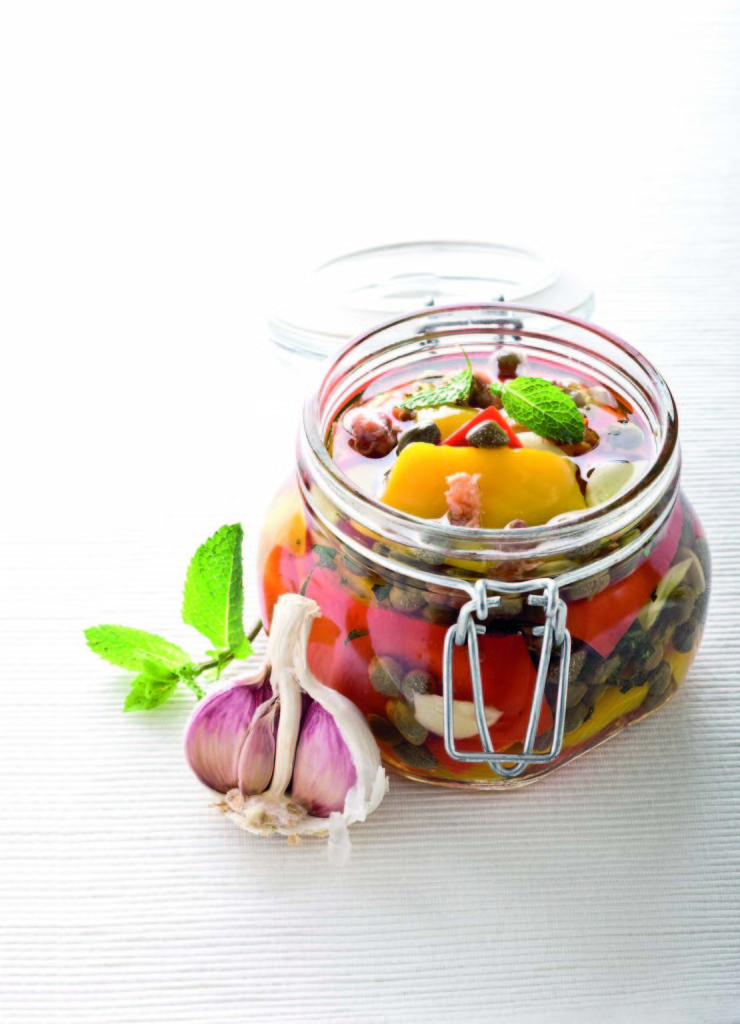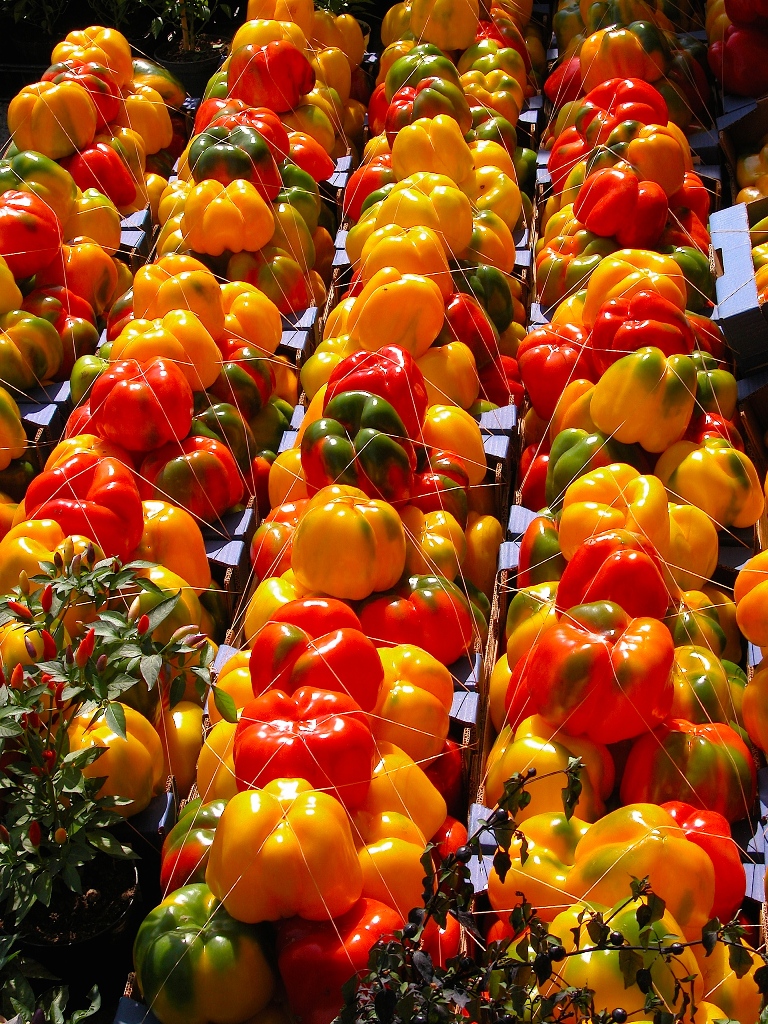 The Pepper of Carmagnola, a town in the province of Turin, is sweet, fragrant, slightly spicy. It is the excellence of the agriculture in Piedmont. In addition to its taste, as well as its particular and unusual shapes, this pepper amazes for its texture and the sensation of freshness its taste offers. This mix is enhanced by strong aromas emanated from its skin. Scientific studies have proved that its tender fibres rich in essences, and the abundant vitamin C and potassium it contains, are the botanical secret of so much scent. In order to preserve the uniqueness of this product, the use of predator insects of plant parasites has been introduced, in order to fight them organically, without the use of pesticides and thus safeguarding the integrity and naturalness of this product.
The Pepper of Carmagnola, a town in the province of Turin, is sweet, fragrant, slightly spicy. It is the excellence of the agriculture in Piedmont. In addition to its taste, as well as its particular and unusual shapes, this pepper amazes for its texture and the sensation of freshness its taste offers. This mix is enhanced by strong aromas emanated from its skin. Scientific studies have proved that its tender fibres rich in essences, and the abundant vitamin C and potassium it contains, are the botanical secret of so much scent. In order to preserve the uniqueness of this product, the use of predator insects of plant parasites has been introduced, in order to fight them organically, without the use of pesticides and thus safeguarding the integrity and naturalness of this product.
The Carmagnola Pepper is grown in one of the most fertile areas of Piedmont, between Turin and Cuneo, whose flat areas and continental climate, with hot summers characterized by little rainfall, are especially favourable for this cultivation.
The crunchy ‘Quadrato’
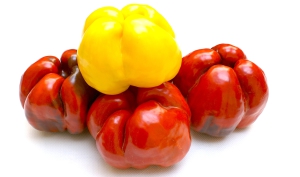 It is the local pepper par excellence, and in the past it was called bragheis in the Piedmontese dialect. It distinguishes itself for its cubic shape and its very thick, sweet, and crisp flesh. It is much appreciated eaten raw, with vinaigrette. Its square shape is made even more special by its spikes, and by its so bright yellow or dark and glossy red, so that it seems artificial. It is sold with a minimum weight of g 250.
It is the local pepper par excellence, and in the past it was called bragheis in the Piedmontese dialect. It distinguishes itself for its cubic shape and its very thick, sweet, and crisp flesh. It is much appreciated eaten raw, with vinaigrette. Its square shape is made even more special by its spikes, and by its so bright yellow or dark and glossy red, so that it seems artificial. It is sold with a minimum weight of g 250.
The tasty ‘Trottola’
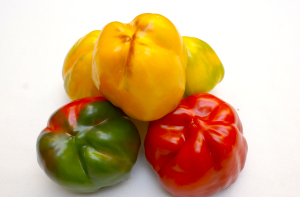 It has a conical and stocky shape, which reminds the game of spinning (in Italian ‘Trottola’), so loved by children. Its pulp is noted for its cool hardness and slightly spicy taste. Even if it is thick, its peel comes off very easily from the pulp. This feature, alongside with its aromatic quality, makes it ideal for baking and grilling. Thanks to its intense scent as well as pleasant and delicate spicy taste, too, it is much appreciated for preserving it in vinegar or for appetizers. This type of pepper, too, is very large, exceeding g 300 for sale.
It has a conical and stocky shape, which reminds the game of spinning (in Italian ‘Trottola’), so loved by children. Its pulp is noted for its cool hardness and slightly spicy taste. Even if it is thick, its peel comes off very easily from the pulp. This feature, alongside with its aromatic quality, makes it ideal for baking and grilling. Thanks to its intense scent as well as pleasant and delicate spicy taste, too, it is much appreciated for preserving it in vinegar or for appetizers. This type of pepper, too, is very large, exceeding g 300 for sale.
The Delicate 'Tumaticot'
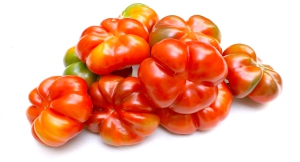 It looks like a round and oblate pepper, with fragrant and tender flesh. Its taste is very delicate, suitable for the most refined preparations, in particular to be stuffed and baked. A preparation typical of Piedmont which is increasingly known abroad, too, is the one of ‘Tumaticot’ in vinegar, used as a side dish for meat and game courses. This precious pepper is light as for its weight, too, starting from g 150 for each piece.
It looks like a round and oblate pepper, with fragrant and tender flesh. Its taste is very delicate, suitable for the most refined preparations, in particular to be stuffed and baked. A preparation typical of Piedmont which is increasingly known abroad, too, is the one of ‘Tumaticot’ in vinegar, used as a side dish for meat and game courses. This precious pepper is light as for its weight, too, starting from g 150 for each piece.
The celebrated 'Corno di Bue’
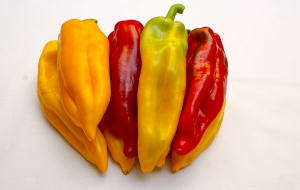 For the inhabitants of Carmagnola, it is the better one, certainly the most scenographic for the intensity of its colours and its elongated conical shape. The Corno di Bue (Ox Horn) is almost sugary and has thick, firm, and meaty pulp. It is excellent raw or with ‘Bagna Cauda’, the sauce prepared with garlic typical of the tradition of Piedmont. It is also traditionally prepared roasted in the oven or flame- seared, because its skin is easily removable. The very sweet Corno di Bue, too, ranks among the lighter peppers, from g 200 for each piece.
For the inhabitants of Carmagnola, it is the better one, certainly the most scenographic for the intensity of its colours and its elongated conical shape. The Corno di Bue (Ox Horn) is almost sugary and has thick, firm, and meaty pulp. It is excellent raw or with ‘Bagna Cauda’, the sauce prepared with garlic typical of the tradition of Piedmont. It is also traditionally prepared roasted in the oven or flame- seared, because its skin is easily removable. The very sweet Corno di Bue, too, ranks among the lighter peppers, from g 200 for each piece.
From Peru to the banks of the Po river
Pepper, an exotic plant which arrived in Europe from Peru in the first half of the sixteenth century, was introduced in the province of Turin only at the beginning of the twentieth century. The Royal Academy of Agriculture of Piedmont selected the sweetest, tasty, and crunchy peppers at the ‘Colonia Agricola di Rivoli’, not far from Turin. The agronomists of that time tried for years to find the right soil for enhancing and preserving these unique features, until the botanical Domenico Ferrero found in the alluvial strip between the right bank of the Po river and the plateau of Poirino the better agricultural situation. At the same time, the cultivation of hemp was coming to an end, with the advent of cotton and synthetic fabrics, thus leaving room for the cultivation of pepper.
Today, this very high-quality vegetable is protected by the Consortium.
Peppers soaked in oil
This is the most classic way in which peasants used to consume raw peppers, so enhancing their sweetness and crispness. After washing and drying it, the pepper is cut into quarters, removing its seeds and white ribs, then cut in smaller pieces which are put in a bowl where they must be sprinkled with salt and wet with plenty of extra virgin olive oil, preferring the delicate oils from Liguria. Chopped anchovy fillets are added, alongside with thinly minced garlic.
Sweet and sour peppers
Remove both seeds and white ribs of kg 3 of peppers. Place in a saucepan g 100 of sugar, 2 cups of extra virgin olive oil, 1 full tablespoon of salt, some bay leaves, 1 litre of mixed white vinegar and white wine. When this mixture boils, dip the peppers cut into segments and continue cooking for about 4 minutes, then shut them when they are still warm in airtight pots with their cooking liquid.
The export
The typical Carmagnola Pepper is marketed in Italy and exported abroad only in wooden boxes and nothing else, if not the mark of the Protected Geographical Indication. Its bright colours and intense perfumes are enough to introduce it.
Export to foreign Countries is recent. Switzerland, France, Germany, Holland, Belgium, and England are the main importers, especially for the ‘Quadrato’ and the ‘Corno di Bue’. The production is of about 3,000 tonnes per year on approximately 300 hectares. These numbers are not huge, but still allow this excellence to be known abroad. From year to year the amount of peppers for canning increases, because in the Northern markets pepper cooked in vinegar or preserved cooked in brine is especially appreciated.

